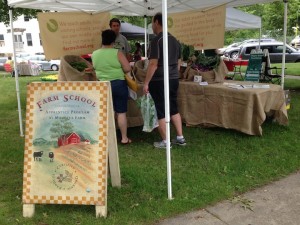
Thomas Lyson, a sociologist, coined the term “civic agriculture” in 1999 to describe “the emergence and growth of community-based agriculture and food production activities that not only meet consumer demands for fresh, safe, and locally produced foods but create jobs, encourage entrepreneurship, and strengthen community identity” (Civic Agriculture: Reconnecting Farm, Food, and Community, University Press of New England, 1999, p. 2).
Lyson pointed to community gardens, farmers markets, and Community Supported Agriculture as evidence that increasing numbers of people were seeing food production as a matter of public concern connected to other social, economic, and environmental issues. Active participation closer to the source of food was, for Lyson, a form of community problem-solving and a way to address some of the shortcomings of large-scale industrialized food systems and economies.
The “Farm Values” project uses this basic definition of civic agriculture. We’re approaching the history of food production in our region as a very long-running debate over who’s putting food on our tables and how that relates to the health and vitality of the small and rural towns of north-central Massachusetts.
Lyson was optimistic that economic development and community resilience can go hand in hand, an idea embraced by many people involved in “re-localization” efforts. “Farm Values” doesn’t argue with that idea, but we do recognize that focusing on the purely economic dimensions of food production has historically created as many problems as it’s solved.
We hope to contribute to a conversation about how people in our area have tried for two centuries to balance the need for livelihood and income with a sense of stewardship for shared places and concern about the kinds of relationships people have with those places and with each other. This is how food and agriculture can be truly “civic,” going beyond an economic relationship of producers and consumers and helping to inform present-day thinking about the best uses of our common resources.
(For a discussion of what some have called “triple bottom line” thinking, including some of its limitations, click here. Anthropologist Laura DeLind has set out a strong case for the danger of equating production and consumption, even in their most “sustainable” modes, with citizenship, which she sees as requiring a wider sense of solidarity, debate, shared action, and sacrifice. See “Place, Work and Civic Agriculture: Common Fields for Cultivation” in Agriculture and Human Values 19 (2002), pp. 217-224.)
One thought on “What is “civic agriculture”?”